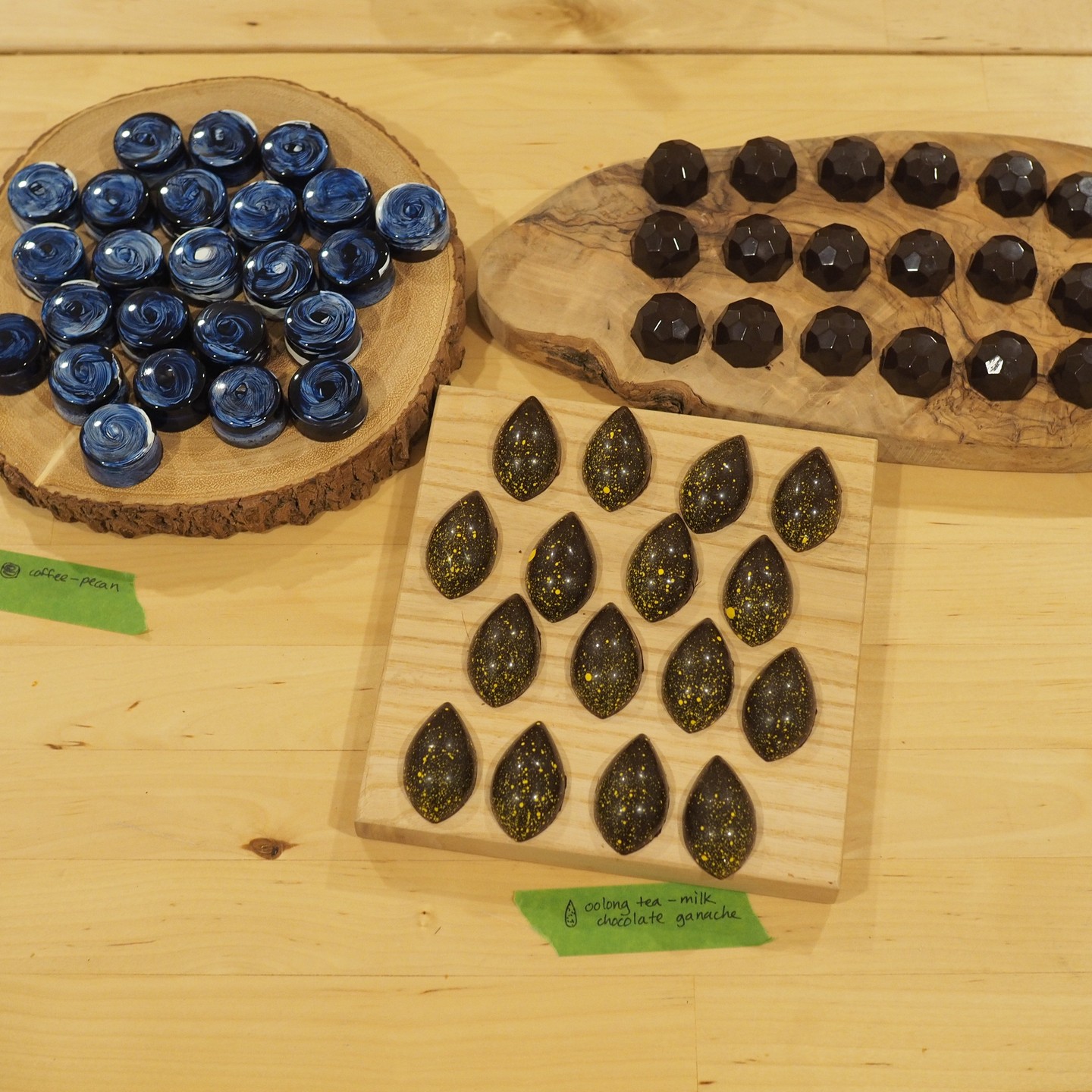Shake-tempering chocolate

I enjoy working with chocolate at home; the bonbons above, from a holiday party last December, were some of my prettier work. Bonbons and many other chocolate applications require tempering the chocolate: finely dispersing tiny cocoa butter crystal seeds throughout otherwise melted chocolate.
There are many tempering methods. You can find lots of guides (most of which will work fine) and science explainers (some of which are true). But I’ve found that for tempering small amounts of chocolate at home, maybe 300g or less, the common methods suffer from at least one of these three problems:
- Low yield – lots of chocolate lost to tools and general mess;
- Labor intensive or time consuming;
- Environmental heat transfer makes the process unreliable.
The third problem arises because small amounts of chocolate have a high surface area to volume ratio, so they quickly gain and lose heat to their environment. For example, a recipe might tell you to melt some chocolate in the microwave to 95F. But if you try this with just 100g of chocolate in a glass bowl, you’ll find that by the time your chocolate is at 95F the bowl is burning hot, and carryover heat from the bowl to the chocolate will take it well beyond 95F.
My preferred method for small quantities is a variant of the standard seeding method, but with shaking to agitate. It goes like so:
- Fully melt your chocolate1 using the method of your choice. We don’t have a specific temperature target here, so no real subtlety other than not scorching your chocolate. I use a microwave.
- Transfer the chocolate to a container that has a lid and is only a bit larger than the chocolate volume. Leave the lid off for now. If you already microwaved in this container, congrats: this step is a no-op. I typically use the same mason jar I microwaved in.
- Prepare 2% of your chocolate’s weight in finely grated dark chocolate. I use a microplane grater.
- Wait for your chocolate to cool to 94-95F. This can take a few minutes, but it’s hands-off and you don’t need to stir continuously. Tip: an infrared thermometer works well for telling you when you should pay attention, but you really want a thermometer tip in the chocolate for a precise reading to know when it’s go time.
- Add the grated chocolate (or just grate direclty in at this point), close the lid, and shake hard for about 30 seconds. Think of crushing ice in a cocktail shaker.
- Your chocolate is now tempered and should be around 90F! A quick stir can confirm no solid chunks remain.
Why this works
- Tempering requires thorough agitation to distribute fine seed crystals uniformly throughout the melted chocolate. Shaking works super well for this and is in general surprisingly powerful, e.g. I can’t crush solid ice in my bare hands, but I can easily crush ice in a cocktail shaker.
- Stirring by hand isn’t vigorous enough, so it takes a long time and with small quantities you’ll often fall out of the correct temperature ranges before you’ve stirred enough.
- An immersion blender is vigorous but generates enough heat to be troublesome with small volumes. Over-aeration is also a risk. Plus, every immersion blender I’ve found is way too big for a little jar with 100g of chocolate in it.2
- Letting the chocolate cool from fully melted in the container you shake in means that by shake time the chocolate isn’t rapidly exchanging heat with its container.
- Finely grating the seed chocolate means it can disperse easily and the heat of the melted chocolate can quickly penetrate each bit of solid seed.
- Empirically, at 94-95F the melted chocolate is warm enough to raise the temperature of the room-temp seed to working temp and easily incorporate the seed, resulting in a final mix at a good working temp of 90-91F. Too much warmer and the seed is fully melted, and too much cooler and you end up with thick chocolate and perhaps still-solid flecks of seed.
-
Temperatures given here are for dark chocolate. I can’t think of why this wouldn’t work with other kinds as well, maybe modulating temperatures a degree or two, but can’t say I’ve tried. The chocolate must be actual cocoa butter based chocolate, not a chocolate-flavored product based on other fats. ↩
-
Product I’d love to buy but can’t find: mini immersion blender with a head about half the diameter of a standard immersion blender, but powerful enough to blend chocolate. Milk frothers have good sized heads but are underpowered for chocolate, which is much more viscous than milk. I know this because I’ve been disappointed by multiple apparently powerful frothers :) ↩